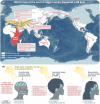Evolution of long scalp hair in humans
- PMID: 39841178
- PMCID: PMC11918595
- DOI: 10.1093/bjd/ljae456
Evolution of long scalp hair in humans
Abstract
The ability to grow long scalp hair is a distinct human characteristic. It probably originally evolved to aid in cooling the sun-exposed head, although the genetic determinants of long hair are largely unknown. Despite ancestral variations in hair growth, long scalp hair is common to all extant human populations, which suggests its emergence before or concurrently with the emergence of anatomically modern humans (AMHs), approximately 300 000 years ago. Long scalp hair in AMHs was also a trait that was selected because it conveyed essential signals related to an individual's age, sexual maturity, health and social status. Biologically, hair length is primarily determined by the amount of time that a hair follicle spends in the active growth phase (anagen). While anagen duration is typically tightly regulated in most mammals, the inherent ability of a hair follicle to continuously recruit new dividing progenitors to its base, where hair fibre is generated, theoretically removes limits on maximal anagen duration. We propose a model wherein hair cycle progression into and out of anagen is regulated by evolutionary malleable molecular checkpoints. Several animal species and domesticated animal breeds display long body hair, which suggests that extremely long scalp hair in humans emerged via attenuation of an existing out-of-anagen checkpoint mechanism rather than via a newly evolved molecular programme. Studying congenital and somatic mosaicism conditions featuring altered hair length could potentially unveil the currently unknown molecular basis underlying this human trait.
Plain language summary
The ability to grow long hair on the scalp is a distinct human characteristic. Hair on the scalp may have originally evolved to aid with cooling of the head when exposed to the sun. However, the genetic determinants of long hair are unknown. All human populations have had long scalp hair, despite ancestral differences in hair growth. This suggests that long hair originated before or at the same time as the emergence of anatomically modern humans (AMHs), approximately 300,000 years ago. Long scalp hair in AMHs was also selected because it represented important messages related to a person’s age, sexual maturity, health and social status. The amount of time that a hair follicle spends in an active growth phase (called ‘anagen’) is the primary biological factor that determines hair length. While anagen duration is regulated in most mammals, the ability of a hair follicle to continuously recruit new dividing progenitors to its base (where hair fibre is generated) theoretically removes limits on the length of duration. We propose a model where hair cycle progression in and out of the active growth phase is controlled by evolutionary malleable molecular checkpoints. Several animal species and domesticated animal breeds display long body hair. This suggests that extremely long scalp hair in humans emerged via attenuation of an existing out-of-anagen checkpoint mechanism, rather than through a newly evolved molecular programme. Studying mosaicism diseases that feature altered hair length could help to identify the molecular basis for this trait in humans.
© The Author(s) 2025. Published by Oxford University Press on behalf of British Association of Dermatologists.
Conflict of interest statement
Conflicts of interest: The authors declare they have no conflicts of interest.
Figures




Similar articles
-
Introduction to Hair Development.Adv Exp Med Biol. 2018;1054:89-96. doi: 10.1007/978-981-10-8195-8_8. Adv Exp Med Biol. 2018. PMID: 29797270 Review.
-
The cross-sectional size and shape of human terminal scalp hair.Br J Dermatol. 1997 Feb;136(2):159-65. Br J Dermatol. 1997. PMID: 9068724
-
Modeling the dynamics of human hair cycles by a follicular automaton.Proc Natl Acad Sci U S A. 2000 Jul 18;97(15):8328-33. doi: 10.1073/pnas.97.15.8328. Proc Natl Acad Sci U S A. 2000. PMID: 10899998 Free PMC article.
-
Prolactin and its receptor are expressed in murine hair follicle epithelium, show hair cycle-dependent expression, and induce catagen.Am J Pathol. 2003 May;162(5):1611-21. doi: 10.1016/S0002-9440(10)64295-2. Am J Pathol. 2003. PMID: 12707045 Free PMC article.
-
Graying: gerontobiology of the hair follicle pigmentary unit.Exp Gerontol. 2001 Jan;36(1):29-54. doi: 10.1016/s0531-5565(00)00210-2. Exp Gerontol. 2001. PMID: 11162910 Review.
Cited by
-
A Comprehensive Review of GWASs of Human Hair Traits.J Invest Dermatol. 2025 Aug 19:S0022-202X(25)02273-0. doi: 10.1016/j.jid.2025.07.004. Online ahead of print. J Invest Dermatol. 2025. PMID: 40828124 Review.
References
-
- Wheeler PE. The evolution of bipedality and loss of functional body hair in hominids. J Hum Evol 1984; 13:91–8.
-
- Kushlan JA. The vestiary hypothesis of human-hair reduction. J Hum Evol 1985; 14:29–32.
Publication types
MeSH terms
Grants and funding
LinkOut - more resources
Full Text Sources

